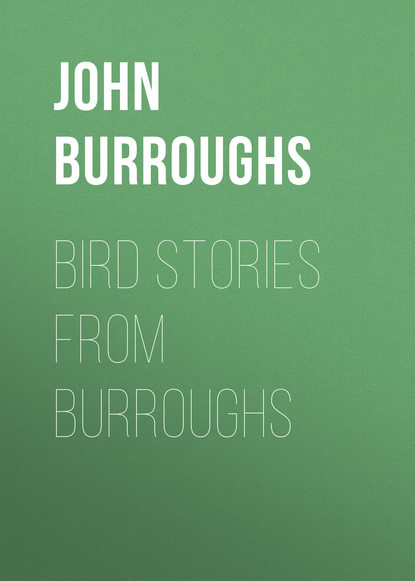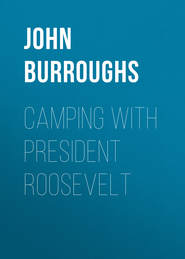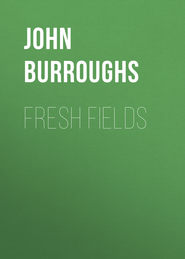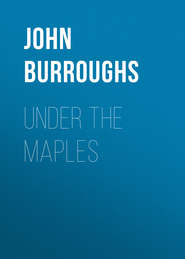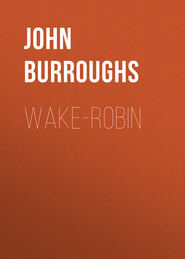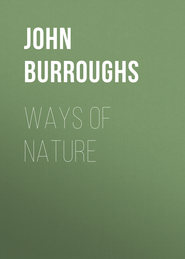По всем вопросам обращайтесь на: info@litportal.ru
(©) 2003-2024.
✖
Bird Stories from Burroughs
Настройки чтения
Размер шрифта
Высота строк
Поля
I wondered what he could feed upon at such a time. There was a light skim of snow upon the ground, and the weather was cold. The wren, so far as I know, is entirely an insect-feeder, and where can he find insects in midwinter in our climate? Probably by searching under bridges, under brush-heaps, in holes and cavities in banks where the sun falls warm. In such places he may find dormant spiders and flies and other hibernating insects or their larvæ. We have a tiny, mosquito-like creature that comes forth in March or in midwinter, as soon as the temperature is a little above freezing. One may see them performing their fantastic air-dances when the air is so chilly that one buttons his overcoat about him in his walk. They are darker than the mosquito, – a sort of dark water-color, – and are very frail to the touch. Maybe the wren knows the hiding-place of these insects.
THE CEDAR-BIRD
How alert and vigilant the birds are, even when absorbed in building their nests! In an open space in the woods I see a pair of cedar-birds collecting moss from the top of a dead tree. Following the direction in which they fly, I soon discover the nest placed in the fork of a small soft maple, which stands amid a thick growth of wild cherry-trees and young beeches. Carefully concealing myself beneath it, without any fear that the workmen will hit me with a chip or let fall a tool, I await the return of the busy pair. Presently I hear the well-known note, and the female sweeps down and settles unsuspectingly into the half-finished structure. Hardly have her wings rested before her eye has penetrated my screen, and with a hurried movement of alarm she darts away. In a moment the male, with a tuft of wool in his beak (for there is a sheep pasture near), joins her, and the two reconnoitre the premises from the surrounding bushes. With their beaks still loaded, they flit round with a frightened look, and refuse to approach the nest till I have moved off and lain down behind a log. Then one of them ventures to alight upon the nest, but, still suspecting all is not right, quickly darts away again. Then they both together come, and after much peeping and spying about, and apparently much anxious consultation, cautiously proceed to work. In less than half an hour it would seem that wool enough has been brought to supply the whole family, real and prospective, with socks, if needles and fingers could be found fine enough to knit it up. In less than a week the female has begun to deposit her eggs, – four of them in as many days, – white tinged with purple, with black spots on the larger end. After two weeks of incubation the young are out.
Excepting the American goldfinch, this bird builds later in the season than any other, its nest, in our northern climate, seldom being undertaken till July. As with the goldfinch, the reason is, probably, that suitable food for the young cannot be had at an earlier period.
I knew a pair of cedar-birds, one season, to build in an apple-tree, the branches of which rubbed against the house. For a day or two before the first straw was laid, I noticed the pair carefully exploring every branch of the tree, the female taking the lead, the male following her with an anxious note and look. It was evident that the wife was to have her choice this time; and, like one who thoroughly knew her mind, she was proceeding to take it. Finally the site was chosen upon a high branch, extending over one low wing of the house. Mutual congratulations and caresses followed, when both birds flew away in quest of building-material. That most freely used is a sort of cotton-bearing plant which grows in old worn-out fields. The nest is large for the size of the bird, and very soft. It is in every respect a first-class domicile.
The cedar-bird is the most silent bird we have. Our neutral-tinted birds, like him, as a rule are our finest songsters; but he has no song or call, uttering only a fine bead-like note on taking flight. This note is the cedar-berry rendered back in sound. When the ox-heart cherries, which he has only recently become acquainted with, have had time to enlarge his pipe and warm his heart, I shall expect more music from him. But in lieu of music, what a pretty compensation are those minute, almost artificial-like, plumes of orange and vermilion that tip the ends of his wing quills! Nature could not give him these and a song too.
THE GOLDFINCH
About the most noticeable bird of August in New York and New England is the yellowbird, or goldfinch. This is one of the last birds to nest, seldom hatching its eggs till late in July. It seems as if a particular kind of food were required to rear its brood, which cannot be had at an earlier date. The seed of the common thistle is apparently its mainstay. There is no prettier sight at this season than a troop of young goldfinches, led by their parents, going from thistle to thistle along the roadside and pulling the ripe heads to pieces for the seed. The plaintive call of the young is one of the characteristic August sounds. Their nests are frequently destroyed, or the eggs thrown from them, by the terrific July thunder-showers. Last season a pair had a nest on the slender branch of a maple in front of the door of the house where I was staying. The eggs were being deposited, and the happy pair had a loving conversation about them many times each day, when one afternoon a very violent storm arose which made the branches of the trees stream out like wildly disheveled hair, quite turning over those on the windward side, and emptying the pretty nest of its eggs. In such cases the birds build anew, – a delay that may bring the incubation into August.
It is a deep, snug, compact nest, with no loose ends hanging, placed in the fork of a small limb of an apple-tree, a peach-tree, or an ornamental shade-tree. The eggs are faint bluish-white.
While the female is sitting, the male feeds her regularly. She calls to him on his approach, or when she hears his voice passing by, in the most affectionate, feminine, childlike tones, the only case I know where the sitting bird makes any sound while in the act of incubation. When a rival male invades the tree, or approaches too near, the male whose nest it holds pursues and reasons or expostulates with him in the same bright, amicable, confiding tones. Indeed, most birds make use of their sweetest notes in war. The song of love is the song of battle too. The male yellowbirds flit about from point to point, apparently assuring each other of the highest sentiments of esteem and consideration, at the same time that one intimates to the other that he is carrying his joke a little too far. It has the effect of saying with mild and good-humored surprise, "Why, my dear sir, this is my territory; you surely do not mean to trespass; permit me to salute you, and to escort you over the line." Yet the intruder does not always take the hint. Occasionally the couple have a brief sparring-match in the air, and mount up and up, beak to beak, to a considerable height, but rarely do they actually come to blows.
The yellowbird becomes active and conspicuous after the other birds have nearly all withdrawn from the stage and become silent, their broods reared and flown. August is his month, his festive season. It is his turn now. The thistles are ripening their seeds, and his nest is undisturbed by jay-bird or crow. He is the first bird I hear in the morning, circling and swinging through the air in that peculiar undulating flight, and calling out on the downward curve of each stroke, "Here we go, here we go!" Every hour in the day he indulges in his circling, billowy flight. It is a part of his musical performance. His course at such times is a deeply undulating line, like the long, gentle roll of the summer sea, the distance from crest to crest or from valley to valley being probably thirty feet; this distance is made with but one brief beating of the wings on the downward curve. As he quickly opens them, they give him a strong upward impulse, and he describes the long arc with them closely folded. Thus, falling and recovering, rising and sinking like dolphins in the sea, he courses through the summer air. In marked contrast to this feat is his manner of flying when he indulges in a brief outburst of song on the wing. Now he flies level, with broad expanded wings nearly as round and as concave as two shells, which beat the air slowly. The song is the chief matter now, and the wings are used only to keep him afloat while delivering it. In the other case, the flight is the main concern, and the voice merely punctuates it.
Among our familiar birds the matchmaking of none other is quite so pretty as that of the goldfinch. The goldfinches stay with us in loose flocks and clad in a dull-olive suit throughout the winter. In May the males begin to put on their bright summer plumage. This is the result of a kind of superficial moulting. Their feathers are not shed, but their dusky covering or overalls are cast off. When the process is only partly completed, the bird has a smutty, unpresentable appearance. But we seldom see them at such times. They seem to retire from society. When the change is complete, and the males have got their bright uniforms of yellow and black, the courting begins. All the goldfinches of a neighborhood collect together and hold a sort of musical festival. To the number of many dozens they may be seen in some large tree, all singing and calling in the most joyous and vivacious manner. The males sing, and the females chirp and call. Whether there is actual competition on a trial of musical abilities of the males before the females or not, I do not know. The best of feeling seems to pervade the company; there is no sign of quarreling or fighting; "all goes merry as a marriage bell," and the matches seem actually to be made during these musical picnics. Before May is passed the birds are seen in couples, and in June housekeeping usually begins. This I call the ideal of love-making among birds, and is in striking contrast to the squabbles and jealousies of most of our songsters.
I have known the goldfinches to keep up this musical and love-making festival through three consecutive days of a cold northeast rainstorm. Bedraggled, but ardent and happy, the birds were not to be dispersed by wind or weather.
THE HEN-HAWK[1 - The red-tailed and red-shouldered hawks are both called hen-hawks.]
August is the month of the high-sailing hawks. The hen-hawk is the most noticeable. He likes the haze and calm of these long, warm days. He is a bird of leisure, and seems always at his ease. How beautiful and majestic are his movements! So self-poised and easy, such an entire absence of haste, such a magnificent amplitude of circles and spirals, such a haughty, imperial grace, and, occasionally, such daring aerial evolutions!
With slow, leisurely movement, rarely vibrating his pinions, he mounts and mounts in an ascending spiral till he appears a mere speck against the summer sky; then, if the mood seizes him, with wings half closed, like a bent bow, he will cleave the air almost perpendicularly, as if intent on dashing himself to pieces against the earth; but on nearing the ground he suddenly mounts again on broad, expanded wing, as if rebounding upon the air, and sails leisurely away. It is the sublimest feat of the season. One holds his breath till he sees him rise again.
If inclined to a more gradual and less precipitous descent, he fixes his eye on some distant point in the earth beneath him, and thither bends his course. He is still almost meteoric in his speed and boldness. You see his path down the heavens, straight as a line; if near, you hear the rush of his wings; his shadow hurtles across the fields, and in an instant you see him quietly perched upon some low tree or decayed stub in a swamp or meadow, with reminiscences of frogs and mice stirring in his maw.
When the south wind blows, it is a study to see three or four of these air-kings at the head of the valley far up toward the mountain, balancing and oscillating upon the strong current; now quite stationary, except for a slight tremulous motion like the poise of a rope-dancer, then rising and falling in long undulations, and seeming to resign themselves passively to the wind; or, again, sailing high and level far above the mountain's peak, no bluster and haste, but, as stated, occasionally a terrible earnestness and speed. Fire at one as he sails overhead, and, unless wounded badly, he will not change his course or gait.
The calmness and dignity of this hawk, when attacked by crows or the kingbird, are well worthy of him. He seldom deigns to notice his noisy and furious antagonists, but deliberately wheels about in that aerial spiral, and mounts and mounts till his pursuers grow dizzy and return to earth again. It is quite original, this mode of getting rid of an unworthy opponent, – rising to heights where the braggart is dazed and bewildered and loses his reckoning! I am not sure but it is worthy of imitation.
THE RUFFED GROUSE, OR PARTRIDGE
Whir! whir! whir! and a brood of half-grown partridges start up like an explosion, a few paces from me, and, scattering, disappear into the bushes on all sides. Let me sit down here behind the screen of ferns and briers, and hear this wild hen of the woods call together her brood. At what an early age the partridge flies! Nature seems to concentrate her energies on the wing, making the safety of the bird a point to be looked after first; and while the body is covered with down, and no signs of feathers are visible there, the wing-quills sprout and unfold, and in an incredibly short time the young make fair headway in flying.
Hark! there arises over there in the brush a soft, persuasive cooing, a sound so subtle and wild and unobtrusive that it requires the most alert and watchful ear to hear it. How gentle and solicitous and full of yearning love! It is the voice of the mother hen. Presently a faint timid "Yeap!" which almost eludes the ear, is heard in various directions, – the young responding. As no danger seems near, the cooing of the parent bird is soon a very audible clucking call, and the young move cautiously in that direction. Let me step never so carefully from my hiding-place, and all sounds instantly cease, and I search in vain for either parent or young.
The partridge is one of our native and most characteristic birds. The woods seem good to be in where I find him. He gives a habitable air to the forest, and one feels as if the rightful occupant were really at home. The woods where I do not find him seem to want something, as if suffering from some neglect of Nature. And then he is such a splendid success, so hardy and vigorous. I think he enjoys the cold and the snow. His wings seem to rustle with more fervency in midwinter. If the snow falls very fast, and promises a heavy storm, he will complacently sit down and allow himself to be snowed under. When you approach him at such times, he suddenly bursts out of the snow at your feet, scattering the flakes in all directions, and goes humming away through the woods like a bomb-shell, – a picture of native spirit and success.
His drum is one of the most welcome and beautiful sounds of spring. Scarcely have the trees expanded their buds, when, in the still April mornings, or toward nightfall, you hear the hum of his devoted wings. He selects, not, as you would predict, a dry and resinous log, but a decayed and crumbling one, seeming to give the preference to old oak-logs that are partly blended with the soil. If a log to his taste cannot be found, he sets up his altar on a rock, which becomes resonant beneath his fervent blows. Who has seen the partridge drum? It is the next thing to catching a weasel asleep, though by much caution and tact it may be done. He does not hug the log, but stands very erect, expands his ruff, gives two introductory blows, pauses half a second, and then resumes, striking faster and faster till the sound becomes a continuous, unbroken whir, the whole lasting less than half a minute. The tips of his wings barely brush the log, so that the sound is produced rather by the force of the blows upon the air and upon his own body as in flying. One log will be used for many years, though not by the same drummer. It seems to be a sort of temple and held in great respect. The bird always approaches on foot, and leaves it in the same quiet manner, unless rudely disturbed. He is very cunning, though his wit is not profound. It is difficult to approach him by stealth; you will try many times before succeeding; but seem to pass by him in a great hurry, making all the noise possible, and with plumage furled he stands as immovable as a knot, allowing you a good view.
The sharp-rayed track of the partridge adds another figure to the fantastic embroidery upon the winter snow. Her course is a clear, strong line, sometimes quite wayward, but generally very direct, steering for the densest, most impenetrable places, – leading you over logs and through brush, alert and expectant, till, suddenly, she bursts up a few yards from you, and goes humming through the trees, – the complete triumph of endurance and vigor. Hardy native bird, may your tracks never be fewer, or your visits to the birch-tree less frequent!
THE PARTRIDGE
List the booming from afar,
Soft as hum of roving bee,
Vague as when on distant bar
Fall the cataracts of the sea.
Yet again, a sound astray,
Was it the humming of the mill?
Was it cannon leagues away?
Or dynamite beyond the hill?
'T is the grouse with kindled soul,
Wistful of his mate and nest,
Sounding forth his vernal roll
On his love-enkindled breast.
List his fervid morning drum,
List his summons soft and deep,
Calling Spice-bush till she come,
Waking Bloodroot from her sleep.
Ah! ruffled drummer, let thy wing
Beat a march the days will heed,
Wake and spur the tardy spring,
Till minstrel voices jocund ring,
And spring is spring in very deed.
THE CROW
The crow may not have the sweet voice which the fox in his flattery attributed to him, but he has a good, strong, native speech nevertheless. How much character there is in it! How much thrift and independence! Of course his plumage is firm, his color decided, his wit quick. He understands you at once and tells you so; so does the hawk by his scornful, defiant whir-r-r-r-r. Hardy, happy outlaws, the crows, how I love them! Alert, social, republican, always able to look out for himself, not afraid of the cold and the snow, fishing when flesh is scarce, and stealing when other resources fail, the crow is a character I would not willingly miss from the landscape. I love to see his track in the snow or the mud, and his graceful pedestrianism about the brown fields.
He is no interloper, but has the air and manner of being thoroughly at home, and in rightful possession of the land. He is no sentimentalist like some of the plaining, disconsolate song-birds, but apparently is always in good health and good spirits. No matter who is sick, or dejected, or unsatisfied, or what the weather is, or what the price of corn, the crow is well and finds life sweet. He is the dusky embodiment of worldly wisdom and prudence. Then he is one of Nature's self-appointed constables and greatly magnifies his office. He would fain arrest every hawk or owl or grimalkin that ventures abroad. I have known a posse of them to beset the fox and cry "Thief!" till Reynard hid himself for shame. Do I say the fox flattered the crow when he told him he had a sweet voice? Yet one of the most musical sounds in nature proceeds from the crow. All the crow tribe, from the blue jay up, are capable of certain low ventriloquial notes that have peculiar cadence and charm. I often hear the crow indulging in his in winter, and am reminded of the sound of the dulcimer. The bird stretches up and exerts himself like a cock in the act of crowing, and gives forth a peculiarly clear, vitreous sound that is sure to arrest and reward your attention. This is, no doubt, the song the fox begged to be favored with, as in delivering it the crow must inevitably let drop the piece of meat.
The crow has fine manners. He always has the walk and air of a lord of the soil. One morning I put out some fresh meat upon the snow near my study window. Presently a crow came and carried it off, and alighted with it upon the ground in the vineyard. While he was eating it, another crow came, and, alighting a few yards away, slowly walked up to within a few feet of this fellow and stopped. I expected to see a struggle over the food, as would have been the case with domestic fowls or animals. Nothing of the kind. The feeding crow stopped eating, regarded the other for a moment, made a gesture or two, and flew away. Then the second crow went up to the food, and proceeded to take his share. Presently the first crow came back, when each seized a portion of the food and flew away with it. Their mutual respect and good-will seemed perfect. Whether it really was so in our human sense, or whether it was simply an illustration of the instinct of mutual support which seems to prevail among gregarious birds, I know not. Birds that are solitary in their habits, like hawks or woodpeckers, behave quite differently toward each other in the presence of their food.
The crow will quickly discover anything that looks like a trap or snare set to catch him, but it takes him a long time to see through the simplest contrivance. As I have above stated, I sometimes place meat on the snow in front of my study window to attract him. On one occasion, after a couple of crows had come to expect something there daily, I suspended a piece of meat by a string from a branch of the tree just over the spot where I usually placed the food. A crow soon discovered it, and came into the tree to see what it meant. His suspicions were aroused. There was some design in that suspended meat, evidently. It was a trap to catch him. He surveyed it from every near branch. He peeked and pried, and was bent on penetrating the mystery. He flew to the ground, and walked about and surveyed it from all sides. Then he took a long walk down about the vineyard as if in hope of hitting upon some clew. Then he came to the tree again, and tried first one eye, then the other, upon it; then to the ground beneath; then he went away and came back; then his fellow came, and they both squinted and investigated, and then disappeared. Chickadees and woodpeckers would alight upon the meat and peck it swinging in the wind, but the crows were fearful. Does this show reflection? Perhaps it does, but I look upon it rather as that instinct of fear and cunning so characteristic of the crow. Two days passed thus: every morning the crows came and surveyed the suspended meat from all points in the tree, and then went away. The third day I placed a large bone on the snow beneath the suspended morsel. Presently one of the crows appeared in the tree, and bent his eye upon the tempting bone. "The mystery deepens," he seemed to say to himself. But after half an hour's investigation, and after approaching several times within a few feet of the food upon the ground, he seemed to conclude there was no connection between it and the piece hanging by the string. So he finally walked up to it and fell to pecking it, flickering his wings all the time, as a sign of his watchfulness. He also turned up his eye, momentarily, to the piece in the air above, as if it might be some disguised sword of Damocles ready to fall upon him. Soon his mate came and alighted on a low branch of the tree. The feeding crow regarded him a moment, and then flew up to his side, as if to give him a turn at the meat. But he refused to run the risk. He evidently looked upon the whole thing as a delusion and a snare, and presently went away, and his mate followed him. Then I placed the bone in one of the main forks of the tree, but the crows kept at a safe distance from it. Then I put it back to the ground, but they grew more and more suspicious; some evil intent in it all, they thought. Finally a dog carried off the bone, and the crows ceased to visit the tree.
From my boyhood I have seen the yearly meeting of the crows in September or October, on a high grassy hill or a wooded ridge. Apparently, all the crows from a large area assemble at these times; you may see them coming, singly or in loose bands, from all directions to the rendezvous, till there are hundreds of them together. They make black an acre or two of ground. At intervals they all rise in the air, and wheel about, all cawing at once. Then to the ground again, or to the tree-tops, as the case may be; then, rising again, they send forth the voice of the multitude. What does it all mean? I notice that this rally is always preliminary to their going into winter quarters. It would be interesting to know just the nature of the communication that takes place between them.
THE CROW
I
My friend and neighbor through the year,
Self-appointed overseer
Of my crops of fruit and grain,
Of my woods and furrowed plain,





